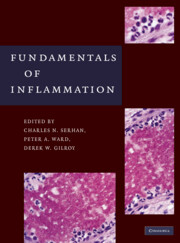Book contents
- Frontmatter
- Contents
- Contributors
- Preface
- PART I THE INFLAMMATORY RESPONSE – AN OVERVIEW
- PART II INDIVIDUAL CELL TYPES
- PART III CHEMICAL MEDIATORS
- PART IV IMMUNOPHARMACOLOGY
- PART V INFLAMMATORY DISEASES/HISTOLOGY
- PART VI ANIMAL MODELS OF INFLAMMATION
- 27 Models of Acute Inflammation – Air-Pouch, Peritonitis, and Ischemia-Reperfusion
- 28A Experimental Models of Glomerulonephritis
- 28B Glomerulonephritis and Ischemia Reperfusion Injury
- 29 Asthma
- 30 Animal Models of Rheumatoid Arthritis
- 31 Ocular Inflammation Models
- 32 Atherosclerosis in Experimental Animal Models
- 33 Oral Inflammation and Periodontitis
- 34 Pathogens and Inflammation
- Index
- References
33 - Oral Inflammation and Periodontitis
from PART VI - ANIMAL MODELS OF INFLAMMATION
Published online by Cambridge University Press: 05 April 2014
- Frontmatter
- Contents
- Contributors
- Preface
- PART I THE INFLAMMATORY RESPONSE – AN OVERVIEW
- PART II INDIVIDUAL CELL TYPES
- PART III CHEMICAL MEDIATORS
- PART IV IMMUNOPHARMACOLOGY
- PART V INFLAMMATORY DISEASES/HISTOLOGY
- PART VI ANIMAL MODELS OF INFLAMMATION
- 27 Models of Acute Inflammation – Air-Pouch, Peritonitis, and Ischemia-Reperfusion
- 28A Experimental Models of Glomerulonephritis
- 28B Glomerulonephritis and Ischemia Reperfusion Injury
- 29 Asthma
- 30 Animal Models of Rheumatoid Arthritis
- 31 Ocular Inflammation Models
- 32 Atherosclerosis in Experimental Animal Models
- 33 Oral Inflammation and Periodontitis
- 34 Pathogens and Inflammation
- Index
- References
Summary
INTRODUCTION
The oral cavity is a complex organ system composed of salivary glands, tongue, tonsils, and teeth. The tissues of the oral cavity are either mineralized-hard (e.g., enamel, dentin, cementum, and bone) or soft tissues (e.g., mucosa, periodontal ligament, and gingiva), which altogether maintain a complex system of function and esthetics. The oral cavity is the entrance to and a major component of the gastrointestinal tract as the first site in the body to break down the food due to its masticatory function; it is also the gateway for respiration. Oral systems are crucial for proper phonation; the alignment of the teeth affects how words are pronounced. Facial esthetics is also directly associated with the shapes of the teeth and soft tissues surrounding them. With this unique blend of components and functions, the health and the disease of the oral cavity, therefore, present an important area of research as well as a challenge to the maintenance of general health. As in many diseases common to humankind, oral pathologies are associated with alterations in tissue homeostasis. Oral pathological conditions and diseases have been recognized as important health problems since the dawn of the early civilizations. For example, golden toothpicks found in Mesopotamia have indicated that Sumerians were practicing oral hygiene as early as 3000 B.C. Various herbal medications were used by Babylonians and Assyrians to “treat” periodontal problems. Egyptians, Chinese, and Indians all have written documentation of treating dental and periodontal inflammation, ulcerations, and abscesses.
- Type
- Chapter
- Information
- Fundamentals of Inflammation , pp. 433 - 447Publisher: Cambridge University PressPrint publication year: 2010



